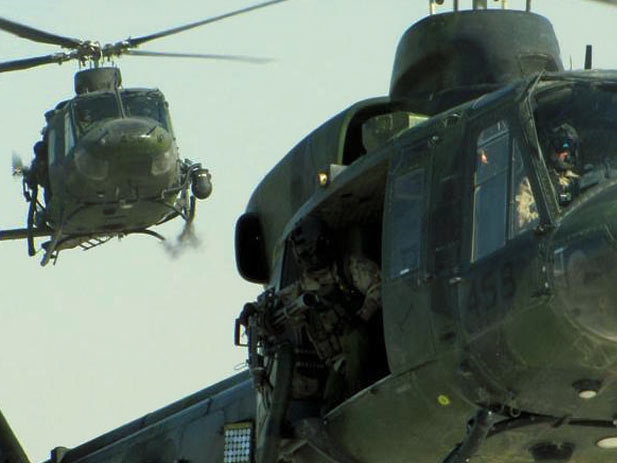
Afghan Air Force returns to flight

The traffic jam never ends at the world's busiest single-runway airport
Nearly every minute of every day, lineups of choppers, fighter jets, transport planes and unmanned drones are either taking off or landing on the same strip of tarmac, providing fits for air traffic controllers and keeping sales of earplugs brisk.
The armada at Kandahar Airfield features a multinational mix of colours and flags: America's stars and stripes; Canada's Maple Leaf; and the concentric circles of Britain's Royal Air Force.
But until recently, almost none of that traffic displayed the black, red and green of Afghanistan. The Afghan air force was essentially out of business, nothing but a national joke.
Over the past 18 months, however, the AAF has been staging a comeback with the help of NATO forces.
"For the Afghans to run their country the way they want, to be able to keep out that terrorist threat, they need an air force," says Maj. Jeffrey Hunziker, a U.S. air force officer who is serving as a trainer.
"And they have come a long way. They can now fly by themselves. As of a year ago, the group we work with wasn't going anywhere without an adviser on board."
Examples of AAF growth are plenty: Hangars under construction; crews taking classes on weapon safety; new residences for air force personnel; even a medical clinic with a dentist's office.
But perhaps the biggest sign of a turnaround is in the proud grin of Col. Abdul Halim, a 27-year veteran of the Afghan air force.
Halim comes from a generation of airmen who learned their skills on Russian-built aircraft that flooded into Afghanistan during the Soviet occupation. When the Soviets withdrew in 1989, he watched the planes and helicopters pass through a succession of warlords, and gradually disintegrate into nothing but scrap metal.
For much of the current war, the air force's Kandahar wing consisted of a pair of dilapidated Mi-17 helicopters that seemed permanently grounded. Today, there are six, all of which are operational, and another five on the way.
More importantly, those helicopters are now being used on missions, Halim says.
The choppers move troops, carry food and firewood on humanitarian operations, and even transport cash to pay Afghan soldiers in the field. On occasion, rocket launchers are strapped on so they can fly as escorts on military campaigns. They've also served as medevac aircraft, and this past week, one crew rescued two labourers whose truck became stuck during a flash flood.
"We have accomplished a lot after starting from zero," Halim says. "If a military does not have an air force, it is not a complete military. It cannot defend itself."
The Kandahar wing expects to get four Italian-made C-27A Spartan transport planes to replace Afghanistan's aging fleet of Antonov-32s. Plans are also in the works to obtain a number of light-attack planes, though the model has not yet been chosen.
"Of course, they want the coolest new thing. They want jet fighters," Hunziker says. "But those are expensive and there's a more difficult level of training."
Despite Halim's optimism at seeing Afghans back in the skies, there is still a wide gap between desire and reality. Long-term plans for the country's air force are modest at best and large technical challenges remain.
NATO's goal is to eventually grow the AAF to 8,000 personnel, compared with targets of 170,000 Afghan soldiers and 135,000 police.
Currently, there are about 1,200 air force spots available at Kandahar Airfield, though only half are filled. Of the staff on the list, only eight are full-time pilots, meaning that a maximum of four helicopters can be taken out at any one time.
And when those helicopters do go out, there's just a handful of places they can fly because most air traffic controllers and battlefield commanders transmit their instructions in English, and few Afghan crews are fluent and able to participate.
To counter that, trainers at Kandahar Airfield are providing daily English lessons from classrooms in the main hangar.
In addition, advisers are still struggling to streamline the Afghans' "supply chain" process that ensures adequate deliveries of uniforms, oil, jet fuel and other staples, U.S. Maj. Jason Church says.
Basic safety lessons are also necessary. At one session this week, a U.S. instructor was warning Afghan crews to keep rockets and other explosive weapons out of the reach of lightning storms.
Then there's the cost. Funding for the operation is largely covered by the United States, and it's unclear if the Afghan government can sustain its air wing once NATO withdraws from the country.
Even among Afghan soldiers, there is little awareness of the AAF.
Hunziker believes the force eventually will find its way through all these challenges.
"We're laying the groundwork. Years from now, I'll be able to look back and say I helped to build that air force," he says.
Source: KANDAHAR AIRFIELD, Afghanistan — Edmonton Journal [canada.com/news]
Photo: A door gunner peers out from a Griffon helicopter that is providing escort for a Chinook transport in Kandahar this year
Photograph by: DND photo by MCpl. Craig Wiggins, DND photo by MCpl. Craig Wiggins
(6.03.2011)
|